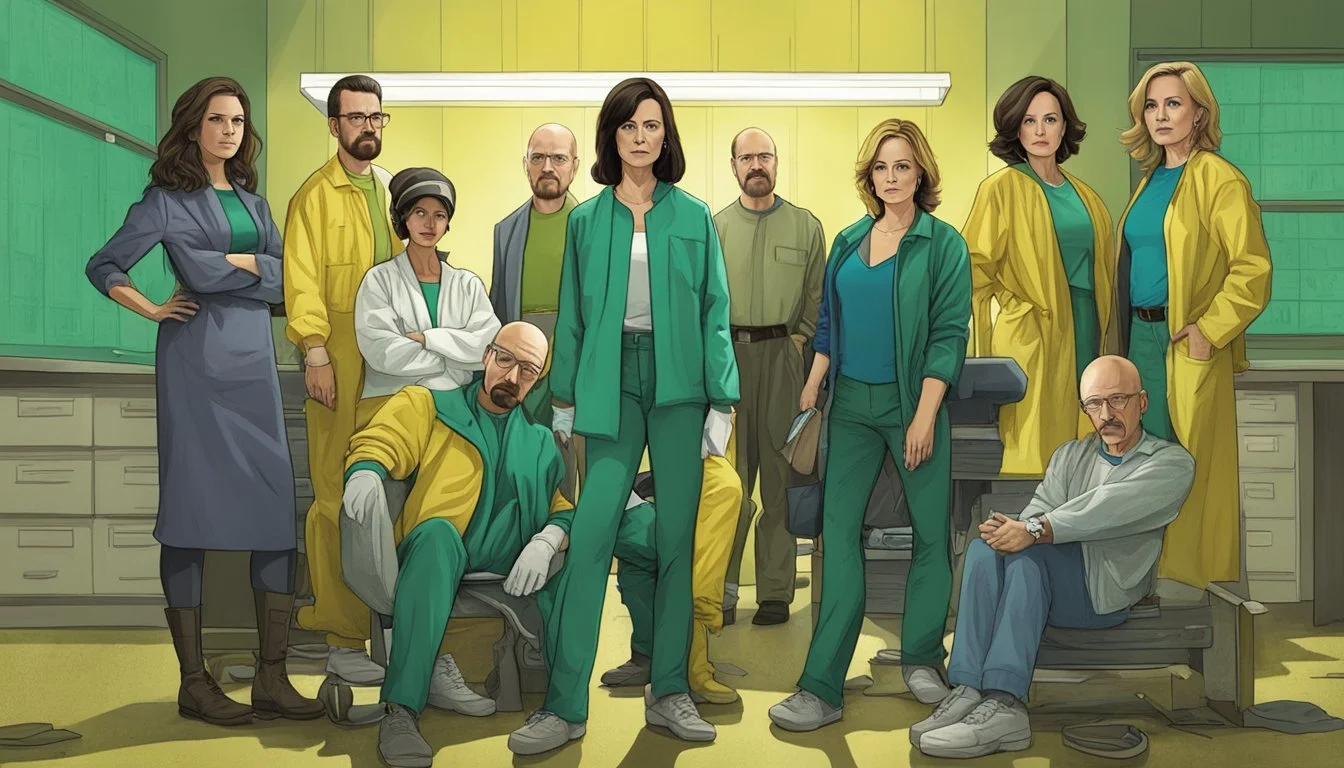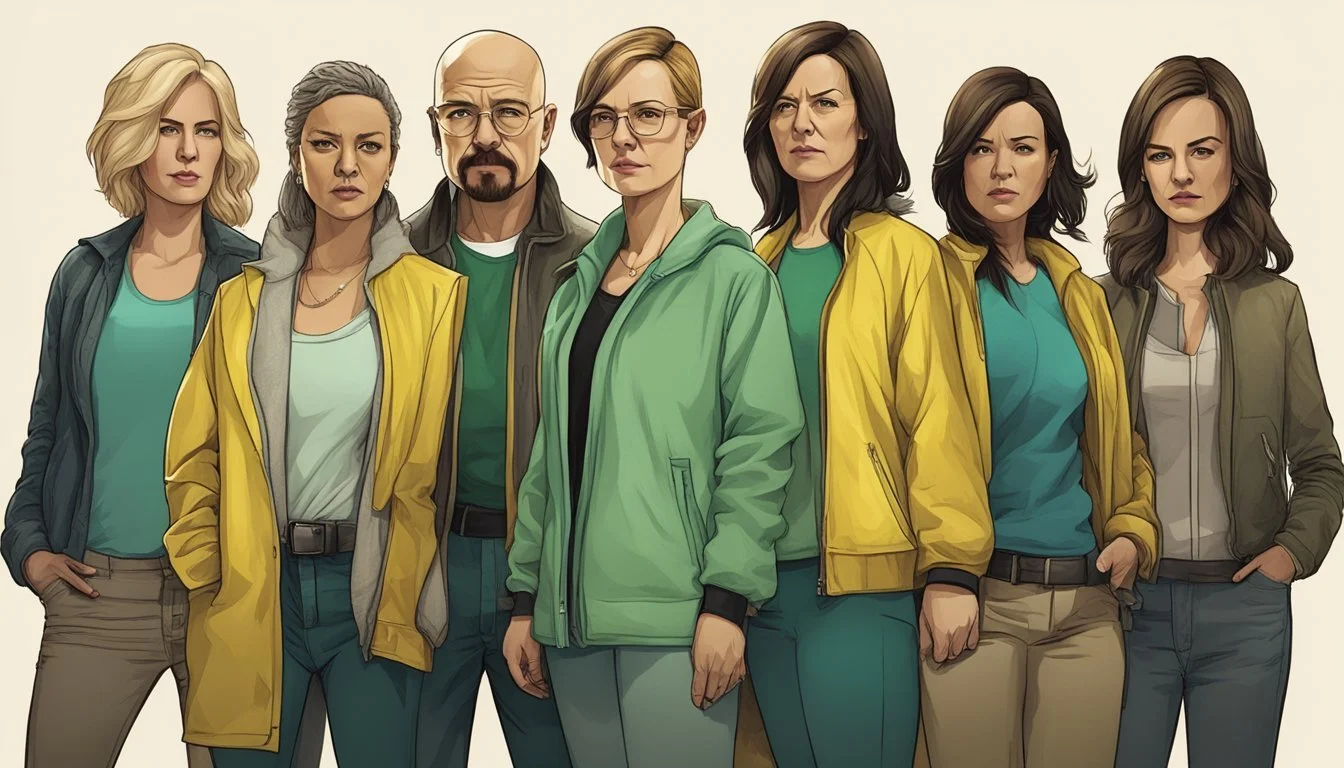The Women of Breaking Bad: More Than Just Supporting Characters
A Deep Dive into Their Complex Roles and Impact
Breaking Bad captivated audiences with its intense storyline and complex characters. While Walter White and Jesse Pinkman took center stage, the show's female characters played pivotal roles that shaped the narrative in significant ways.
Skyler White, Marie Schrader, and Jane Margolis were more than just supporting players in the Breaking Bad universe. These women challenged traditional gender roles and added depth to the story, proving their impact extended far beyond conventional supporting character archetypes. Their actions and decisions often drove the plot forward and provided crucial counterpoints to the male-dominated world of drug manufacturing and distribution.
The women of Breaking Bad brought their own motivations, strengths, and flaws to the series. From Skyler's transformation from oblivious housewife to active participant in Walter's criminal enterprise to Marie's struggle with kleptomania and loyalty to her husband Hank, these characters offered nuanced portrayals that defied simple categorization. Their presence enriched the show's exploration of moral ambiguity and the consequences of choices made under extreme circumstances.
The Central Role of Skyler White
Skyler White emerges as a pivotal character in Breaking Bad, evolving from a supportive wife to a complex individual grappling with moral dilemmas. Her journey intertwines with Walter's descent into criminality, showcasing her resilience and adaptability.
Character Arc and Development
Skyler begins as a pregnant homemaker, initially unaware of Walter's illicit activities. As the series progresses, she transforms into a shrewd and calculating individual. Her character evolves from naive to assertive, demonstrating remarkable strength in the face of adversity.
Skyler's development is marked by key moments:
Confronting Walter about his lies
Taking control of the family's finances
Learning bookkeeping to launder money
These experiences shape her into a multifaceted character, capable of making difficult decisions to protect her family.
Interactions With Walter White
Skyler and Walter's relationship forms the emotional core of Breaking Bad. Their interactions reveal the strain that Walter's choices place on their marriage. Initially supportive, Skyler becomes increasingly suspicious and confrontational.
Key aspects of their dynamic include:
Skyler's growing distrust
Walter's manipulation and lies
Power struggles within their marriage
As Walter descends deeper into the criminal world, Skyler's role shifts from passive observer to active participant, challenging the traditional notion of a submissive wife.
Involvement in the Meth Operation
Skyler's gradual entanglement in Walter's meth empire showcases her pragmatism and intelligence. She transitions from an unwitting bystander to a crucial player in the money laundering operation.
Her involvement includes:
Managing the car wash as a front business
Creating elaborate financial schemes
Negotiating with dangerous associates
Skyler's business acumen proves invaluable, demonstrating that she's more than capable of handling complex criminal enterprises.
Moral Complexity and Viewer Reception
Skyler's character sparked intense debates among viewers, highlighting the show's exploration of moral ambiguity. Her actions often challenged audience expectations, leading to diverse interpretations of her role.
Factors contributing to her complex reception:
Perceived obstacles to Walter's goals
Critiques of traditional gender roles
Exploration of survival instincts in extreme situations
Skyler's journey forces viewers to confront uncomfortable truths about morality and survival, making her one of Breaking Bad's most thought-provoking characters.
Marie Schrader: Beyond Hank's Wife
Marie Schrader is a complex character with her own struggles and contributions to the Breaking Bad narrative. Her kleptomania, support for her family, and involvement in Hank's work reveal a multifaceted personality beyond her role as Hank's wife.
Kleptomania and Personal Struggles
Marie's kleptomania is a defining aspect of her character. She repeatedly steals small items from stores and open houses, revealing deep-seated emotional issues. This compulsive behavior strains her relationships, particularly with Skyler and Hank.
Marie's obsession with the color purple extends to her clothing and home decor. This fixation may symbolize her desire for luxury and status, or serve as a coping mechanism for her inner turmoil.
Despite her flaws, Marie attempts to address her kleptomania through therapy. This demonstrates her awareness of her problems and willingness to improve herself.
Supporting Skyler and the White Family
Marie plays a crucial role in supporting her sister Skyler during difficult times. She offers emotional support and practical help when Skyler faces challenges in her marriage to Walt.
As Walt's criminal activities escalate, Marie becomes a confidante for Skyler. She provides a safe space for her sister to express her fears and frustrations.
Marie's loyalty to her family is tested when she learns the truth about Walt's illegal activities. Her initial shock and disbelief give way to anger and a desire to protect her niece and nephew.
Role in Hank's Life and DEA Investigations
Marie is more than just Hank's supportive wife; she actively engages with his work at the DEA. She shows genuine interest in his cases and offers emotional support during challenging investigations.
When Hank is injured in the line of duty, Marie becomes his primary caregiver. Her dedication to his recovery showcases her strength and commitment to their marriage.
Marie's involvement in Hank's pursuit of Heisenberg adds depth to her character. She becomes a sounding board for his theories and encourages him to continue his investigation, even when others doubt him.
Supporting Players: Jane, Andrea, and Lydia
Jane Margolis, Andrea Cantillo, and Lydia Rodarte-Quayle played pivotal roles in Breaking Bad's narrative. These women influenced key events and character arcs, particularly Jesse Pinkman's journey and the expansion of the drug empire.
Jane Margolis: Jesse's Love Interest and Her Impact
Jane Margolis entered Jesse's life as his landlord and quickly became his girlfriend. Their relationship intensified Jesse's drug use and strained his partnership with Walter White.
Jane's death by choking on her own vomit while high on heroin marked a turning point in the series. Walt's decision not to save her revealed the depths of his moral decay.
This tragic event had far-reaching consequences, pushing Jesse into rehab and setting off a chain of events that led to the Wayfarer 515 crash. Jane's father, an air traffic controller, caused the accident due to his grief.
Andrea Cantillo and Her Connection to Jesse and the Drug Trade
Andrea Cantillo provided Jesse with a chance at redemption and a normal life outside the drug world. Their relationship began at a Narcotics Anonymous meeting and grew into a romantic connection.
Andrea's young son Brock became a surrogate child figure for Jesse. This attachment was exploited when Walt poisoned Brock to manipulate Jesse, highlighting the ruthlessness of the drug trade.
Andrea's murder by Todd Alquist served as brutal punishment for Jesse's escape attempt. This act demonstrated the high stakes and collateral damage in the meth business.
Lydia Rodarte-Quayle: The Corporate Face of the Meth Business
Lydia Rodarte-Quayle represented the intersection of corporate America and the illegal drug trade. As a Madrigal Electromotive executive, she used her business acumen to expand the meth operation internationally.
Her paranoia and meticulous nature made her both an asset and a liability to her criminal partners. Lydia's insistence on quality and her connections helped elevate the meth business to new heights.
Walt's decision to poison Lydia with ricin in the series finale underscored her importance to the operation. Her death symbolized the dismantling of the drug empire she helped build.
Gretchen Schwartz: Past and Influence on Walter White
Gretchen Schwartz plays a pivotal role in Walter White's backstory and ongoing character development in Breaking Bad. Her presence, though intermittent, carries significant weight in shaping Walt's motivations and decisions throughout the series.
Backstory with Walter and Contribution to Characterization
Gretchen and Walter share a complex history that predates the events of Breaking Bad. They were once engaged and worked together as chemistry lab partners. Their relationship ended abruptly when Walt left Gretchen after feeling inferior at a dinner with her wealthy family.
This rejection of Gretchen and her affluent background hints at Walt's deep-seated insecurities and pride. These traits later fuel his transformation into Heisenberg, as he seeks to prove his worth and reclaim lost opportunities.
Gretchen went on to marry Elliott Schwartz, Walt's former colleague. Together, they founded Gray Matter Technologies, a company built on Walt's research that became wildly successful without him.
Intermittent Presence and Symbolic Significance
Though not a constant presence in the series, Gretchen's occasional appearances serve as powerful reminders of Walt's past choices and unfulfilled potential. She symbolizes the life Walt could have had - one of wealth, respect, and scientific achievement.
Walt's resentment towards Gretchen and Elliott intensifies as his criminal empire grows. He falsely claims they stole his research, using this perceived injustice to justify his illegal activities.
Gretchen's attempts to reach out to Walt are met with hostility. In one pivotal scene, Walt rejects her offer to pay for his cancer treatment, choosing instead to continue cooking meth.
This interaction underscores Walt's pride and his commitment to building his own legacy, however morally dubious. Gretchen thus becomes a catalyst for Walt's continued descent into the criminal underworld.
Characterization: A Study of Agency and Motivation
The women of Breaking Bad exhibit complex characterization through their decision-making and interactions within the criminal world. Their motivations and agency shape their roles beyond mere supporting characters.
Comprehensive Analysis of Female Characters' Decision-Making
Skyler White demonstrates agency through her evolving response to Walt's criminal activities. Initially shocked, she later becomes complicit, making calculated decisions to protect her family. Marie Schrader's kleptomania reflects her desire for control in an unstable environment. Lydia Rodarte-Quayle, a high-ranking executive in Madrigal Electromotive, actively pursues power within the drug trade.
These characters' choices reveal depth beyond stereotypical portrayals. Skyler's money laundering skills and Lydia's business acumen challenge traditional gender roles in crime dramas.
The Representation of Women in Criminal Environment
Breaking Bad portrays women navigating a male-dominated criminal landscape. Skyler's transformation from homemaker to reluctant accomplice highlights the show's exploration of female agency in illicit spheres. Lydia's ruthless ambition as a drug distributor subverts expectations of women in organized crime.
The series examines how these characters adapt to and influence their dangerous surroundings. Their actions and motivations are not simplified or glamorized, but presented as morally complex responses to extraordinary circumstances.
Visual Representation and Symbolism
Breaking Bad's visual elements convey deeper meanings about its female characters. Color choices and settings provide insight into their personalities and roles.
Use of Color and Wardrobe in Defining Characters
The show's color palette plays a crucial role in characterizing its women. Marie Schrader's association with the color purple is particularly notable. Her wardrobe and home decor heavily feature this hue, symbolizing her complexity and desire for luxury.
Purple also represents Marie's struggle with kleptomania, hinting at her inner turmoil. This color choice sets her apart visually from other characters, emphasizing her unique personality.
Skyler White's wardrobe evolves throughout the series. Early on, she wears soft blues and greens, reflecting her initial innocence. As she becomes entangled in Walt's crimes, her clothing shifts to darker tones, mirroring her moral compromise.
Symbolic Location Choices: Albuquerque as a Backdrop
Albuquerque serves as more than just a setting; it's a character itself, influencing the women's stories. The city's desert landscape symbolizes isolation and moral ambiguity, themes central to the female characters' arcs.
The White family home transforms from a sanctuary to a prison for Skyler. This change in perception is visually represented through lighting and camera angles as the series progresses.
Locations like the car wash and Beneke Fabricators become symbols of Skyler's attempts at independence and her eventual entanglement in illegal activities. These places showcase her evolution from housewife to reluctant accomplice.
Impact and Legacy of Female Characters in Breaking Bad
The female characters in Breaking Bad left an indelible mark on television. They challenged stereotypes and expanded the complexity of women's roles in prestige dramas.
Critical Analysis on the Influence of Female Roles
Skyler White emerged as a pivotal character, evolving from a concerned wife to a cunning accomplice. Her transformation showcased the show's commitment to multifaceted female roles.
Marie Schrader's character arc demonstrated resilience in the face of personal and family turmoil. Her struggles with kleptomania added depth to the series' exploration of moral ambiguity.
Jane Margolis, despite her brief appearance, significantly impacted the storyline. Her relationship with Jesse highlighted the human cost of the drug trade.
These characters sparked discussions about agency, morality, and the consequences of choices in a male-dominated narrative.
Changing Perspectives on Women in the Series Over Time
As Breaking Bad progressed, the female characters gained more prominence and complexity. Initial portrayals gave way to nuanced depictions that challenged viewer expectations.
Skyler's role shifted from a potential antagonist to a woman navigating impossible circumstances. This evolution reflected changing attitudes towards female characters in television.
The series gradually expanded the screen time and storylines for its female cast. This shift allowed for a more balanced narrative, showcasing the women's strengths and vulnerabilities.
By the final season, characters like Lydia Rodarte-Quayle demonstrated that women could be as ruthless and ambitious as their male counterparts in the criminal underworld.





